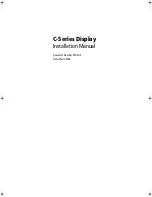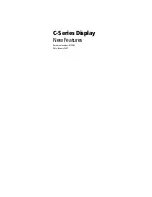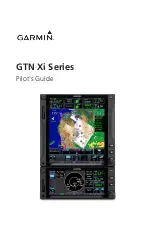
190-00592-06 Rev. A
Garmin G1000 Pilot’s Guide for the Diamond DA40/40F
SY
STEM
O
VER
VIEW
FLIGHT
INSTRUMENTS
EIS
AUDIO P
ANEL
& CNS
FLIGHT
MANA
GEMENT
HAZARD
AV
OID
ANCE
AFCS
ADDITIONAL
FEA
TURES
APPENDICES
INDEX
513
APPENDIX E
GENERAL TIS INFORMATION
NOTE
:
Aircraft without an operating transponder are invisible to TIS.
NOTE
:
TIS is not intended to be used as a collision avoidance system and does not relieve the pilot of the
responsibility to “see and avoid” other aircraft. TIS should not be used for avoidance maneuvers during
instrument meteorological conditions (IMC) or when there is no visual contact with the intruder aircraft.
The Traffic Information Service (TIS) provides traffic advisory information to non-TAS/TCAS-equipped aircraft.
TIS is a ground-based service providing the relative locations of all ATCRBS Mode-A and Mode-C transponder
equipped aircraft within a specified service volume. The TIS ground sensor uses real-time track reports to generate
traffic notification. The G1000 System displays TIS traffic information on the Traffic Map Page of the MFD. TIS
information may also be displayed for overlay on the MFD Navigation Map Page, as well as on the PFD Inset
Map. Surveillance data includes all transponder-equipped aircraft within the coverage volume. The G1000
System displays up to eight traffic targets within a 7.5-nm radius, from 3,000 feet below, to 3,500 feet above the
requesting aircraft.
The main difference between the Traffic Information System (TIS) and Traffic Advisory (TAS) or Traffic Collision
Avoidance Systems (TCAS) is the source of surveillance data. TAS/TCAS uses an airborne interrogator with a half-
second update rate, while TIS utilizes the terminal Mode-S ground interrogator and accompanying data link to
provide a five-second update rate. TIS and TAS/TCAS have similar ranges.
TIS relies on surveillance of the Mode-S radar system, which is a “secondary surveillance” radar system similar
to that used by ATCRBS. Many limitations are inherent in secondary radar surveillance. Information provided by
TIS is neither better nor more accurate than the information used by ATC. TIS is intended only to assist in visual
acquisition of other aircraft in visual meteorological conditions (VMC). While TIS is a useful aid for visual traffic
avoidance, system limitations must be considered to ensure proper use. No recommended avoidance maneuvers
are given, nor authorized, as a direct result of a TIS intruder display or TIS advisory.
• TIS operation may be intermittent during turns or other maneuvering.
• TIS is dependent on two-way, line-of-sight communications between the aircraft and the Mode-S radar antenna.
Whenever the structure of the aircraft comes between the transponder antenna and the ground-based radar
antenna, the signal may be temporarily interrupted.
NOTE:
Refer to the TIS Limitations section of the Aeronautical Information Manual (AIM) for a more
comprehensive explanation of limitations and anomalies associated with TIS.
NOTE
:
TIS is unavailable at low altitudes in many areas of the United States. This is often the case in
mountainous regions.
Summary of Contents for Diamond DA40
Page 1: ...System Software 0321 20 or later G1000 Integrated Flight Deck Pilot s Guide...
Page 2: ......
Page 537: ......














































